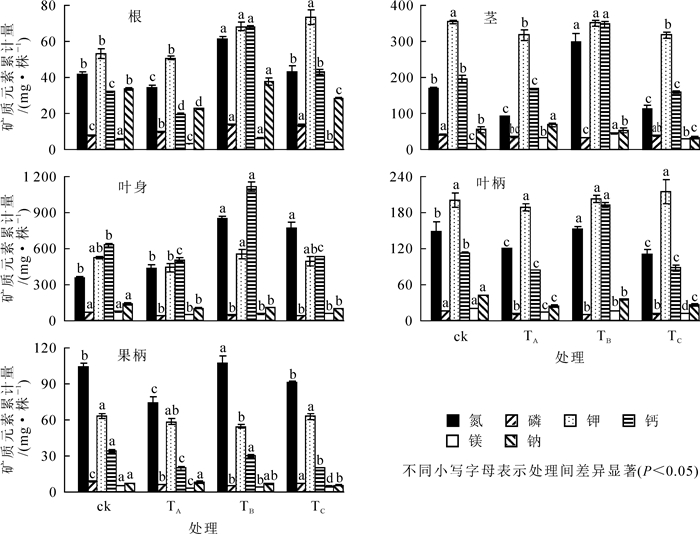-
作为常见生活果蔬,高糖度、高风味番茄Lycopersicon esculentum受到消费者的追逐青睐。营养液膜栽培(nutrient film technique,NFT)是水培的一种主要栽培方式,能提高栽培番茄根系活力,促进植株生长及干物质积累,从而提高番茄产量和果实风味物质[1]。高温和弱光的逆境条件下水培番茄的适应能力优于土培番茄[2-3]。水肥是影响果实品质的主要因素,科学合理的水肥供液是生产高糖度番茄的必要条件。分析供液量及供液频率对番茄生长生理指标、产量品质及水分利率的影响,有助于筛选较为理想的生产高糖度番茄的营养液供液[4]。矿质元素是作物生长发育的营养源,是影响作物品质和产量形成的首要因素,了解矿质营养元素吸收利用规律,实现矿质营养的均衡供应,对提高果实的品质影响重大[5]。本研究以番茄‘京番302’Lycopersicon esculentum ‘Jingfan 302’为试材,比较不同营养液配比对番茄植株生长、矿质元素的累积、果实品质和产量的影响,利用皮尔森分析法评价各指标间的相关性,筛选出番茄最适栽培比例,以期为生产高糖、高风味NFT培番茄提供理论依据。
HTML
-
试验于2018年3-7月在宁夏贺兰园艺产业园科研开发区进行。试验温室为文洛型玻璃温室(23.0 m × 18.0 m),栽培槽规格为20.0 m × 35.5 cm × 10.0 cm,槽底铺设20.0 m × 100.0 cm的黑白膜(白面朝上)与20.0 m × 35.0 cm的无纺布,黑白膜利于营养液的流动与番茄植株底部的采光,无纺布利于保水。为保证营养液温度稳定,使用500.0 L塑料储液罐供液,并将储液罐9/10的体积埋入土内。番茄植株定植时采用8.5 cm × 8.5 cm × 6.5 cm的岩棉块固定,定植后使用泡沫板覆盖栽培槽,以减少营养液蒸发。
供试番茄‘京番302’由北京市农林科学院蔬菜研究中心提供。粉果,早熟,无限生长型,果实圆形,单果质量220.0~260.0 g;具有抗根结线虫病Mi1基因位点、抗番茄花叶病毒病Tm2a基因位点,耐裂性好,适合春秋保护地或露地种植。
-
试验所用基础营养液配方为日本园试1.0单位,具体配方化学组成为:七水硫酸镁492.00 mg·L-1,磷酸氢二胺152.00 mg·L-1,四水硝酸钙944.00 mg·L-1,硝酸钾808.00 mg·L-1,其中微量元素为:铁3.00 mg·L-1,硼和锰各0.50 mg·L-1,锌0.05 mg·L-1,铜0.02 mg·L-1,钼0.01 mg·L-1。试验采用完全随机区组设计,共设置4个处理(表 1):日本园试1.0单位配方作为对照(ck);日本园试2.0单位(TA);日本园试1.0单位添加氯化钙(TB),其中氯化钙质量浓度参照文献[6]确定;日本园试1.5单位并调整钾氮比(TC),其中氯化钾质量浓度参照文献[7-8]确定。设定小区3个·处理-1,定植37株·小区-1。番茄定植后用清水缓苗5 d,按所设置的营养液配比进行试验。营养液采用24 h连续供液方式,试验前期每15 d彻底更换营养液,后期每7 d更换1次。
处理 营养液配比 ck 日本园试1.0单位,电导率为0.20 S·m-1 TA 日本园试2.0单位,电导率为0.38 S·m-1 TB 日本园试1.0单位添加氯化钙,电导率值为0.31 S·m-1 TC 日本园试1.5单位调整钾氮比。定植到第1穗果实最大直径1.5 cm前,调整ρ钾:ρ氮=1.29:1.00,电导率为0.26 S·m-1;第1穗果实最大直径1.5 cm至第1穗果实采收时,调整ρ钾:ρ氮=2.50:1.00,电导率值为0.53 S·m-1;第1穗果实采收至拉秧时,调整ρ钾:ρ氮=2.00:1.00,电导率为0.45 S·m-1 Table 1. Different treatment nutrient solution ratio and conductivity
-
植株长至5穗果时,测定各处理株高(茎基部起至植株生长点顶端),拉秧时测定茎粗(第2穗果下1.0 cm处)。
-
植株长至始收期,取4株·处理-1,按根、茎、叶身、叶柄、果柄分别收获,烘干并测定干质量;粉碎后测定各部位矿质元素元素质量分数,采用硫酸-高氯酸消煮,用蒸馏法测定氮元素质量分数,用钼锑抗比色法测定磷元素质量分数,火焰光度法测定钾、钠元素质量分数,用原子吸收分光光度法测定钙、镁质量分数[9]。矿质元素累积量=矿质元素质量分数×干物质质量。分配率=(某矿质元素累积量/矿质元素累积量总量)×100%。
-
盛果期随机收获番茄鲜果,5个·处理-1。用游标卡尺分别测定鲜果纵径、横径,计算果形指数。用无损检测仪(K-BA100R)测定可溶性固形物质量;用钼蓝比色法[10]测定维生素C质量分数。随机收获鲜果10个·处理-1,105 ℃杀青0.5 h,75 ℃烘干后粉碎,测定氮、磷、钾、钠、钙、镁质量分数,测定方法同植株矿质元素。
-
果实成熟时按第1穗果至第5穗果分别称质量,计算每一穗平均单株产量,最后计算整株单株产量。
-
采用Excel 2016整理数据,使用SPSS 21.0软件进行方差分析和相关性分析。
1.1. 试验材料
1.2. 试验设计
1.3. 测定项目及方法
1.3.1. 番茄生长指标的测定
1.3.2. 植株干物质及矿质元素的测定
1.3.3. 番茄品质的测定
1.3.4. 番茄产量
1.4. 数据处理
-
由表 2可知:番茄植株茎粗、根、叶身、叶柄干物质量随着营养液质量浓度的增大而增高,至TB处理时达到最大值,此后下降。说明高质量浓度营养液抑制番茄植株的各部位干物量的积累,添加氯化钙后干物质累积增加。TC处理下株高显著高于对照(P<0.05),但与TA和TB处理差异不显著。说明高质量浓度营养液并调整钾氮比,有利于株高的生长,钾可以促进植株的生长发育。相比于处理组,对照组果柄干物质量显著提高(P<0.05)。
处理 株高/cm 茎粗/cm 各部位干物质量/(g·株-1) 根 茎 叶身 叶柄 果柄 ck 132.64 ± 3.42 b 15.32 ± 0.86 a 4.27 ± 0.22 a 18.53 ± 0.35 b 31.37 ± 0.47 ab 9.67 ± 0.09 ab 4.37 ± 0.09 a TA 137.02 ± 2.02 ab 15.33 ± 0.90 a 3.93 ± 0.21 a 19.03 ± 0.94 b 26.23 ± 1.23 c 8.33 ± 0.27 c 3.47 ± 0.20 c TB 138.40 ± 2.35 ab 16.94 ± 0.83 a 4.59 ± 0.17 a 23.33 ± 0.55 a 35.93 ± 0.72 a 10.37 ± 0.30 a 3.80 ± 0.12 bc TC 148.04 ± 5.97 a 16.12 ± 0.54 a 4.40 ± 0.20 a 18.57 ± 0.54 b 28.60 ± 0.46 bc 8.50 ± 0.64 c 3.93 ± 0.07 b 说明:不同字母表示处理间差异显著(P<0.05) Table 2. Effects of different treatments on plant height, stem diameter, and biomass of nutrient film technique (NFT) cultured tomato
-
如图 1所示:矿质元素的累积量主要分布在番茄植株的叶身、茎和叶柄中,而根和果柄的累积量相对较少,且各元素累积量在番茄植株各部位中均以氮、钾、钙高于磷、镁、钠。随着营养液质量浓度的增加,氮、钙元素在各部位的累积量总体均有所降低,各部位中氮、钙元素累积量在TB处理下最大,因此营养液中添加氯化钙对番茄植株各部位氮、钙元素的累积量有显著影响。TC处理后根、叶中钾元素累积量在显著高于其他处理(P<0.05),叶柄和果柄中则无显著变化;由此认为营养液中调整钾氮比可以促进根和叶身钾的累积量。与对照相比,各处理组根系与果柄中磷元素累积量显著提高,茎、叶身、叶柄中则有所降低,表明提高营养液质量浓度、添加氯化钙、调整钾氮比利于磷元素在根系与果柄中累积,而不利于在茎、叶身、叶柄中的累积。与对照相比,其他处理组叶身、叶柄、果柄中镁元素累积量显著降低(P<0.05);TB处理后茎中镁元素累积量显著高于其他处理,推断添加氯化钙可以促进茎对镁元素的累积。相比对照,其他处理下叶身、叶柄、果柄中钠元素累积量降低;钠元素累积量在TB处理下的根中和TA处理下的茎中达到最大值,分别为37.83和68.16 mg·株-1,表明提高营养液质量浓度、添加氯化钙及调整钾氮比可降低钠元素在叶身、叶柄和果柄中的累积量,促进根和茎对钠元素的累积。

Figure 1. Effects of different treatments on the accumulation of mineral elements in different parts of tomato
由图 2可知:番茄不同部位矿质元素分配模式存在较大的差异。氮元素主要向果柄分配,不同处理间差异明显,TB处理分配率最高,达51.62%。磷、钠元素主要向根和茎分配,根中磷元素和茎中钠元素均以TA处理分配率最大,分别为6.95%和9.55%;茎中磷元素TC处理最高,分配率为6.95%,根中钠元素分配率以对照组最高,达19.41%。钾在各部位中分配率均较高,TC处理下番茄茎中钾元素分配率最高,达45.77%。钙元素主要向茎和叶身分配,均以TC处理最高,其值分别为30.76%和40.80%。由此说明营养液中添加氯化钙对矿质元素在不同部位的分配率影响较大。
-
由表 3可知:营养液膜水培条件下,番茄果型指数、可溶性固形物和氮质量分数间均无显著差异。TA处理下,维生素C质量分数显著提高(P<0.05),达28.42 mg·kg-1,提示高质量浓度营养液利于维生素C形成。与对照相比,其他处理组有机酸质量摩尔浓度显著提高(P<0.05),提示添加氯化钙、提高营养液质量浓度或调整钾氮比会阻碍果实有机酸的合成。果实中磷质量分数随营养液质量浓度增加而增加,TA处理与其他处理差异显著(P<0.05);钾和钠的质量分数中各处理均低于对照且处理之间无显著差异;TB处理下钙质量分数增大,达2.50 g·kg-1,与其他处理差异显著(P<0.05);TC处理后镁质量分数显著高于其他处理(P<0.05)。
处理 果形指数 w维生素C/
(mg·kg-1)可溶性固形物/% b有机酸/
(mol·g-1)w氮/
(g·kg-1)w磷/
(g·kg-1)w钾/
(g·kg-1)w钙/
(g·kg-1)w镁/
(g·kg-1)w钠/
(g·kg-1)ck 0.86±0.00 a 19.11±1.29 b 6.22±0.43 a 0.43±0.03 b 14.20±0.45 a 1.14±0.01 b 18.52±0.24 b 0.78±0.04 bc 1.34±0.05 b 1.41±0.15 b TA 0.84±0.06 a 28.42±0.67 a 6.87±0.33 a 0.50±0.00 a 13.85±0.41 a 1.27±0.04 a 19.69±0.24 a 0.72±0.03 c 1.20±0.11 b 1.25±0.00 a TB 0.88±0.03 a 18.99±1.08 b 6.52±0.72 a 0.47±0.01 ab 14.87±0.21 a 1.11±0.02 b 19.36±0.27 a 2.50±0.23 a 1.32±0.07 b 1.24±0.00 a TC 0.86±0.03 a 18.20±1.69 b 6.50±0.03 a 0.46±0.01 ab 14.39±0.33 a 1.30±0.00 a 19.34±0.24 a 1.25±0.12 b 1.84±0.13 a 1.26±0.00 a 说明:不同字母表示处理间差异显著(P<0.05) Table 3. Effects of different treatments on tomato quality and mineral element content in NFT culture
-
由表 4可以看出:不同处理对番茄第1穗果、第2穗果、第3穗果和第5穗果的单株产量无显著差异。TB处理下第4穗果时产量显著高于其他处理;相对于对照,TC处理单株产量下降(P<0.05),其他处理则无显著差异。综合不同处理各穗之间产量来看,TB处理后产量较高于其他处理,因此营养液中增加氯化钙对NFT培番茄产量达到增产的效果具有一定的影响作用。
处理 m第1穗果/kg m第2穗果/kg m第3穗果/kg m第4穗果/kg m第5穗果/kg m单株产量/kg ck 0.47 ± 0.03 a 0.56 ± 0.03 a 0.43 ± 0.03 a 0.38 ± 0.02 b 0.38 ± 0.02 a 2.22 ± 0.08 ab TA 0.52 ± 0.07 a 0.52 ± 0.02 a 0.42 ± 0.01 a 0.37 ± 0.02 b 0.37 ± 0.02 a 2.21 ± 0.13 ab TB 0.50 ± 0.05 a 0.49 ± 0.12 a 0.49 ± 0.06 a 0.49 ± 0.01 a 0.43 ± 0.05 a 2.41 ± 0.09 a TC 0.52 ± 0.03 a 0.52 ± 0.02 a 0.43 ± 0.06 a 0.31 ± 0.05 b 0.31 ± 0.05 a 2.09 ± 0.03 b 说明:不同字母表示处理间差异显著(P<0.05) Table 4. Effects of different treatments on tomato yield in NFT culture
-
由表 5皮尔森相关性分析结果可知:植株氮累积量与植株钾累积量、果实钙含量呈极显著正相关(P<0.01),相关系数分别为0.633和0.823;与植株钙累积量、果实氮含量呈显著正相关(P<0.05)。植株磷累积量与植株钠呈显著正相关(P<0.05)、与果实钠含量呈极显著正相关关系(P<0.01),而与果实磷、钾含量呈极显著负相关(P<0.01),相关系数分别为-0.800和-0.710。植株钙累积量与果实钙质量分数显著正相关(P<0.05),但与果实镁和钠质量分数显著负相关(P<0.05)。果实磷与植株镁、钠累积量和果实镁质量分数呈极显著负相关(P<0.01),果实镁与植株镁累积量呈显著负相关关系(P<0.05)。就果实品质而言,维生素C质量分数与植株钾累积量呈负相关;果实磷质量分数与可溶性固形物呈正相关,与有机酸呈显著负相关(P<0.05);植株磷和钾累积量与有机酸也具有负相关关系。对产量影响较大的是植株钙和镁累积量呈正相关,相关系数达0.614和0.682,果实镁质量分数对产量也影响较大,两者呈负相关。
PN PP PK PCa PMg PNa FN FP FK FCa FMg FNa VC SS Oa Y PN 1 PP -0.255 1 PK 0.633* 0.439 1 PCa 0.823** -0.091 0.566 1 PMg 0.389 0.500 0.670* 0.670* 1 PNa -0.192 0.743** 0.383 0.277 0.701* 1 FN 0.614* -0.215 0.396 0.536 0.464 -0.075 1 FP -0.046 -0.800** -0.543 -0.293 -0.735** -0.795** -0.269 1 FK 0.235 -0.710** -0.019 0.014 -0.414 -0.521 0.126 0.674* 1 FCa 0.925** -0.302 0.477 0.914** 0.396 -0.070 0.524 -0.048 0.154 1 FMg -0.263 -0.338 -0.370 -0.696* -0.607* -0.725** -0.096 0.525 0.334 -0.447 1 FNa -0.364 0.606* 0.160 -0.600* -0.127 0.046 -0.305 -0.237 -0.286 -0.545 0.430 1 VC -0.555 -0.387 -0.668* -0.352 -0.403 -0.103 -0.543 0.520 0.327 -0.411 0.181 -0.276 1 SS -0.180 -0.190 0.080 -0.120 0.360 -0.190 -0.130 0.586* 0.240 -0.02 0.350 -0.497 -0.183 1 Oa -0.136 -0.621* -0.592* -0.055 -0.349 -0.392 -0.351 0.715** 0.236 0.014 0.124 -0.441 0.712** -0.566 1 Y 0.306 0.146 0.351 0.614* 0.682* 0.520 0.187 -0.362 -0.260 0.385 -0.586* -0.559 -0.108 0.077 0.004 1 说明:PN.植株氮累积量;PP.植株磷累积量;PK.植株钾累积量;PCa.植株钙累积量;PMg.植株镁累积量;PNa.植株钠累积量;FN.果实氮含量;FP.果实磷含量;FK.果实钾含量;FCa.果实钙含量;FMg.果实镁含量;FNa.果实钠含量;Vc.维生素C;SS.可溶性固形物;Oa.有机酸;Y.单株产量。*表示显著相关(P<0.05),**表示极显著相关(P<0.01) Table 5. Correlation between the accumulation of mineral elements and the quality and yield of tomato grown in NFT
2.1. 不同处理对番茄生长指标的影响
2.2. 不同处理对植株不同部位元素累积量和分配率的影响
2.3. 不同处理对番茄果实品质的影响
2.4. 不同处理对番茄产量的影响
2.5. 植株及果实矿质元素累积与番茄品质和产量的相关性分析
-
本研究表明:营养液膜栽培条件下,日本园试1.5单位调整钾氮比(TC)处理对植株株高、茎粗具有一定的促进作用,证明提高营养液浓度并调整钾氮比利于番茄植株的生长发育,与柳美玉等[11]研究结果类似。日本园试1.0单位添加氯化钙(TB)明显增加了番茄植株干物质,说明高质量浓度的营养液并不利于植株生长发育[12]。
矿质元素是植株体内重要的组成部分,也是产量形成的基础。本试验中番茄植株中各元素累积量基本表现为钾>氮>钙>钠>镁>磷,表明番茄是喜钾作物,与ROUPHAEL等[13]研究结果一致。矿质元素累积分配是合理施肥重要依据。本研究发现:番茄不同部位中各矿质元素累积量均表现为叶身、茎、叶柄大于果柄和根,氮元素主要向果柄分配,磷、钠主要向根和茎分配,钙和镁主要向叶身、茎和根分配,与王萍[14]和李娟等[15]研究结果类似。柳美玉等[11]、ZHANG等[16]和牛佳等[17]研究结果则显示:随着营养液质量浓度的提高,植株中各营养元素质量分数也随之提高,但在本实验中并未发现此规律。本研究发现:与对照相比,TC处理显著降低了植株各部位中钙、镁、钠的累积量,各部位氮、钾、钙的累积量均有明显下降,叶身、叶柄、果柄中的磷、镁、钠的累积量也有明显下降,说明营养液质量浓度过高并不利于植株各部位中矿质元素的累积,这可能与离子间拮抗有一定关系。TB处理显著提高了不同部位中各矿质元素的累积量,可以认为高糖度NFT培番茄生产中并不需要采取等量增加营养液质量浓度的栽培方式,TB处理是NFT培条件下生产高糖度番茄最适的营养液质量浓度。
营养液膜栽培条件下,各处理间番茄果型指数间无显著差异,这可能与番茄品种有关;与前人研究结果相比,维生素C、可溶性固形物、有机酸等相对含量均有显著提高,质量浓度越高,维生素C、有机酸相对含量越大。本研究发现:番茄体内钾和氮元素质量分数显著高于其他元素;一般地,氮、磷、钾、镁、钠等元素在植株体的积累量并不随营养液质量浓度的增大而增大,但本研究的营养液膜栽培番茄矿质元素一定程度上与营养液质量浓度正相关。由此认为营养液膜栽培模式下,高质量浓度营养液可提高番茄的风味物质;这一论点受到皮尔森相关性分析的验证,果实磷含量与果实钾、溶性固形物、有机酸呈正相关,原因可能是磷参与能量代谢过程,促进糖类的合成转化和运输[18]。
不同质量浓度营养液栽植番茄,与其他处理相比,TB处理对番茄第四穗和单株产量促进作用显著,皮尔森相关性分析可看出果实中钙和镁含量与产量呈正相关,原因可能是钙对植物抗病有一定的作用,镁对光合作用有重要意义[19],一定程度上促进了番茄产量。但高质量浓度营养液并不能提高番茄产量,日本园试2.0单位(TA)处理下,番茄单株产量反而下降;由此认为适当增施肥料可达到增产的效果,一旦施肥过量番茄产量反而会降低[20-22]。
综上所述,日本园试1.0单位添加氯化钙(TB处理)可明显增加番茄植株干物质量,有效提高各部位对矿质元素的累积量,一定程度上提升番茄品质并且增加了番茄的产量。TB处理是理想的营养液配方,结合营养液膜栽培技术,可为生产高糖度、高风味番茄提供一些科学的理论依据。











 DownLoad:
DownLoad:
